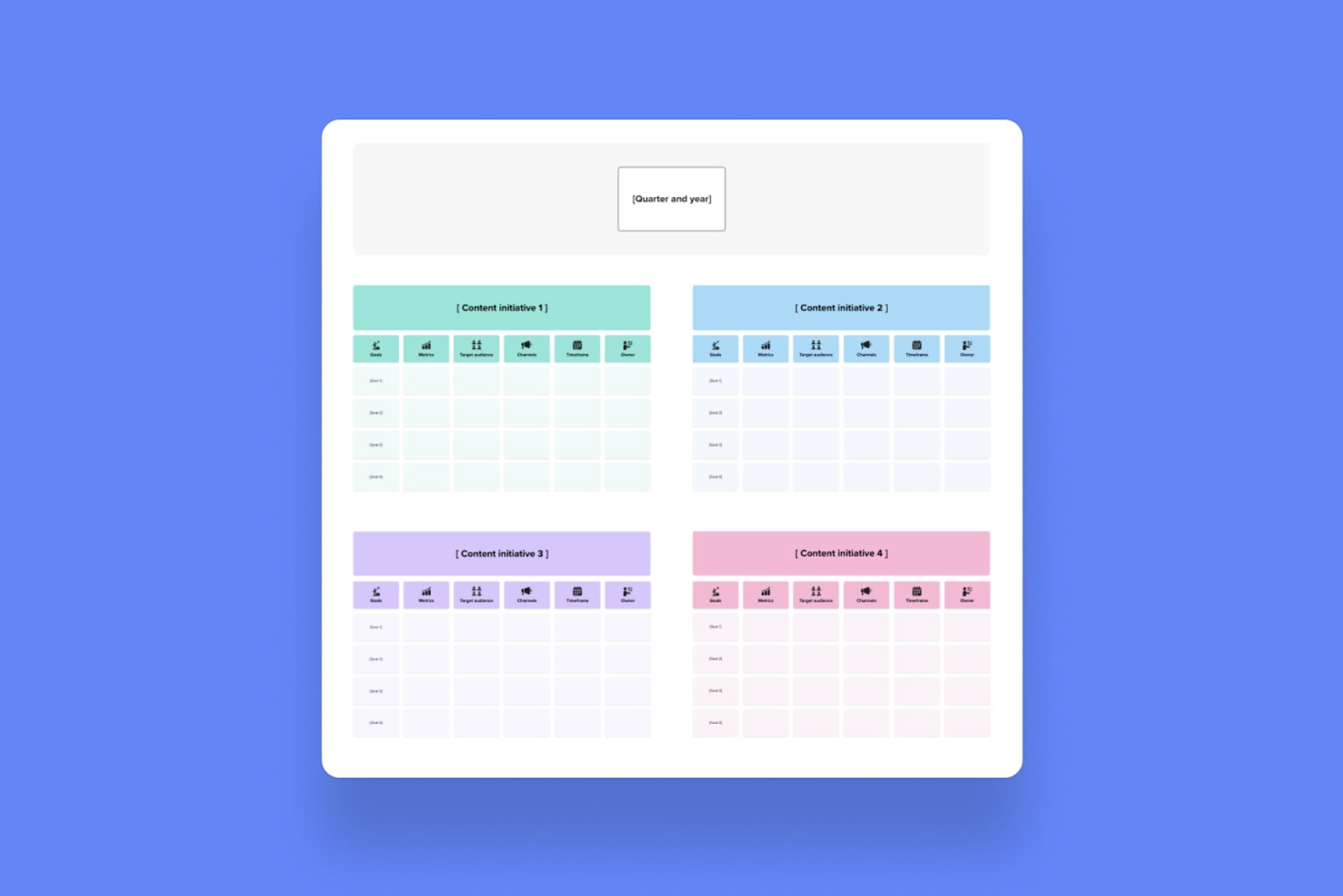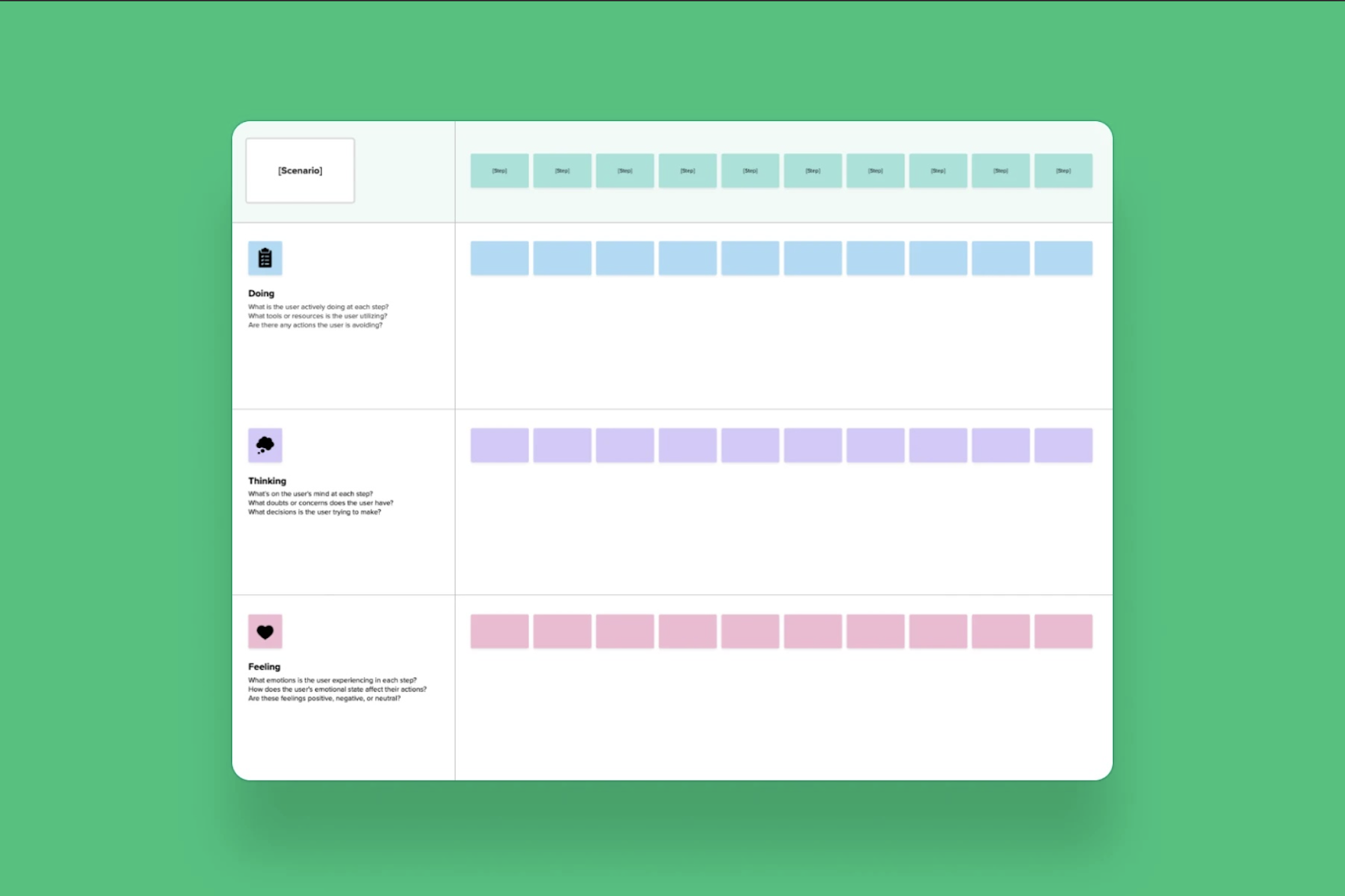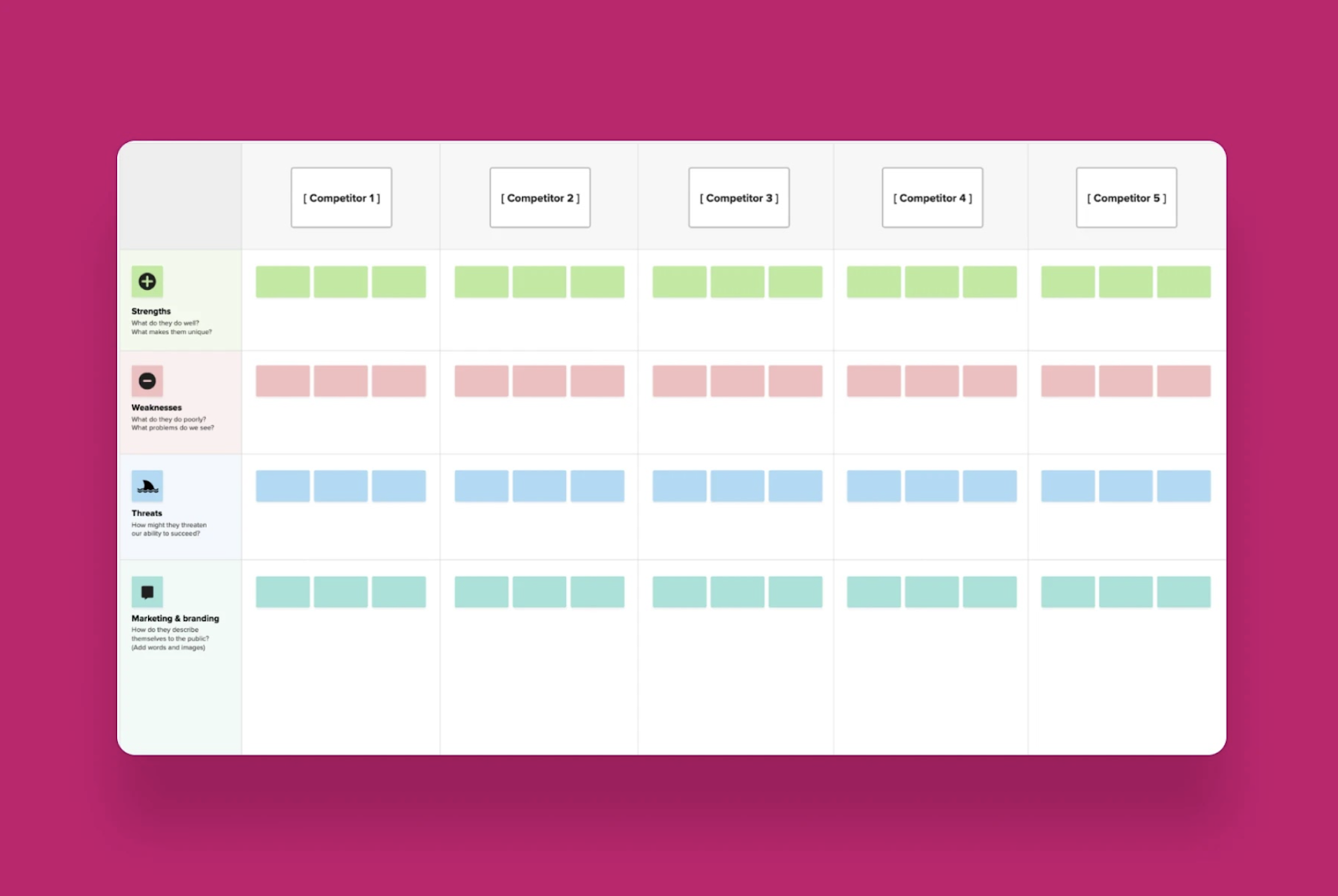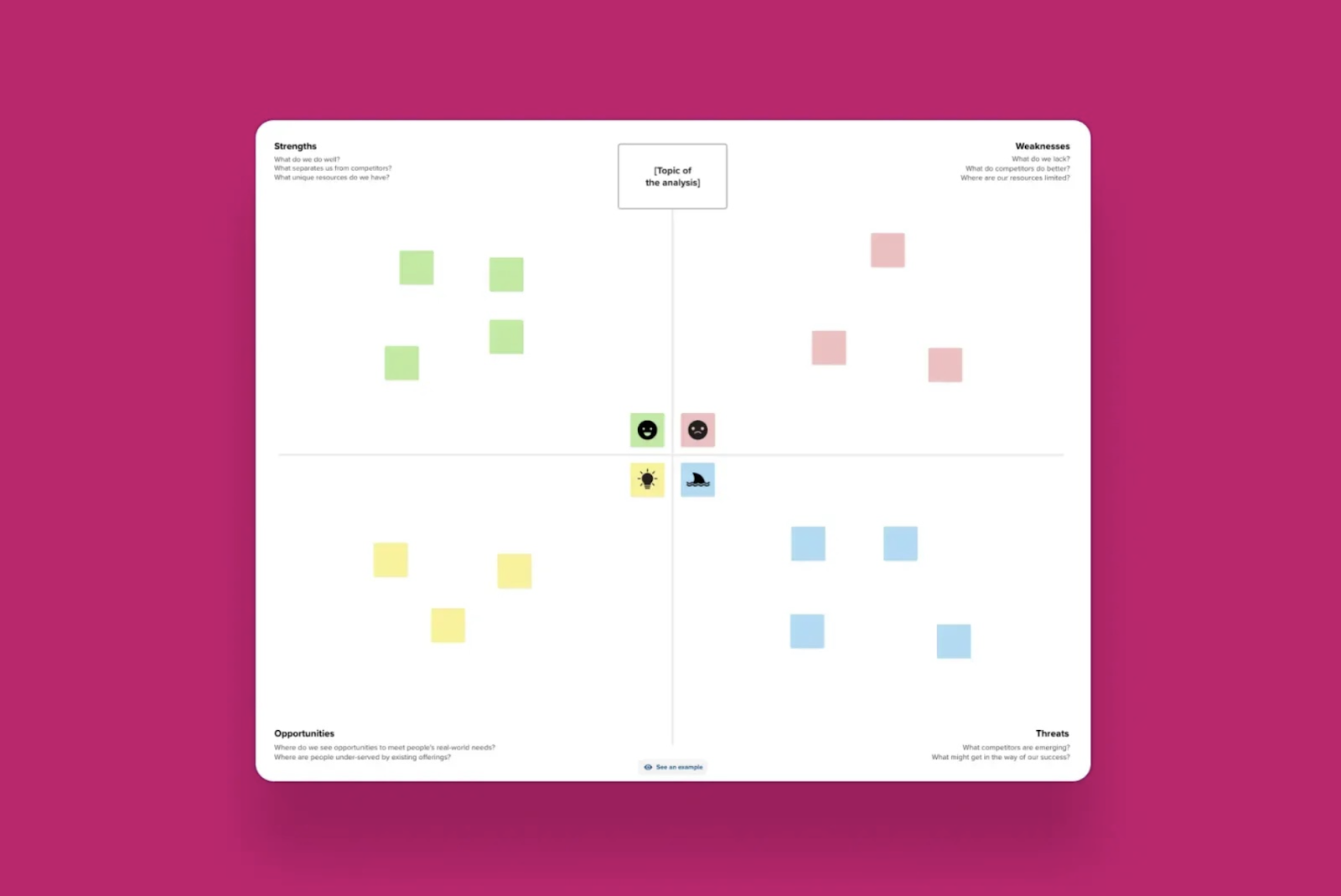In today’s fast-paced business world, collaboration between sales and marketing teams isn’t just a nice-to-have — it’s essential. National Sales and Marketing Collaboration Day is the perfect moment to reflect on how better alignment, shared insights, and joint planning can drive growth and customer success.
To help your teams break down silos and work together seamlessly, we’ve curated 10 powerful Mural workflows designed specifically to accelerate collaboration across sales, marketing, product, and leadership. These digital workspaces provide structure, clarity, and a shared language to turn ideas into action.
Let’s dive in!
1. Content strategy

A solid content plan is the backbone of marketing success. Mural’s content strategy workflow guides your team through setting clear goals, defining, and planning distribution channels — all in one collaborative space. It is especially useful for sales and marketing teams to co-create a unified content plan that aligns messaging with customer pain points and sales objectives. By ensuring content efforts align with business objectives and resonate with your target audience, this workflow can reduce guesswork and speed up execution.
Perfect for: Building or refreshing a content strategy that aligns marketing messaging with sales enablement — whether you're planning a campaign, launching a product, or auditing existing content.
Bonus: Cuts through scattered docs and siloed planning — sales and marketing can finally co-own the strategy in one shared space.
2. Go-to-market (GTM) strategy

Bringing a product to market requires precise coordination across departments. The go-to-market strategy workflow offers a step-by-step solution, where sales and marketing can jointly define ideal customers, messaging, and positioning. By aligning marketing, sales, product, and support teams around customer personas and business goals, your team can stay ahead of competitors by moving quickly and smartly, bringing your experiences and products to market faster.
Perfect for: Collaboratively planning product launches, campaign rollouts, or new market entries — with sales and marketing working from the same page from day one.
Bonus: No more fragmented launch docs — align your cross-functional teams around a single source of truth that covers audience, messaging, timing, and tactics.
3. Work breakdown structure

When campaigns, product launches, or events span multiple teams, clarity can break down quickly. This workflow gives sales and marketing teams a shared framework to break large initiatives into smaller, manageable tasks across each project phase. With a clear visual structure of every workstream, it becomes easier to coordinate deliverables, timelines, and responsibilities.
Perfect for: Structuring cross-functional projects like campaign launches or GTM rollouts where both teams need to see how their efforts ladder up to the overall strategy — and to each other. It helps sales and marketing stay aligned on priorities, milestones, and dependencies across the entire funnel.
Bonus: You can tag team members, comment in real time, and track progress as the project evolves — making it a living blueprint for collaboration.
4. Design critique

Great design is collaborative — and it’s not just for product or UX teams. This workflow helps sales and marketing teams critically evaluate campaign concepts, creative assets, landing pages, or content layouts before they go live. It creates a shared space to anticipate how users will experience your work, so you can catch issues early and improve performance.
Perfect for: Reviewing ad creative, product messaging, sales enablement assets, or even website flows — especially when you want feedback from cross-functional partners before launch. This structured critique process gets teams aligned on what “good” looks like and avoids last-minute surprises that can derail timelines or results.
Bonus: Use it as a dry-run environment for campaigns — you’ll spot friction points before your customers do.
5. Scenario map

When you take time to walk through real-world user scenarios together, you create space for empathy, shared insight, and fresh ideas. This collaborative approach helps marketing and sales teams uncover what users truly need by finding smarter, more meaningful ways to improve their experience. For sales teams, they often surface real customer friction points. Meanwhile, marketing teams uncover messaging gaps. This workflow gives both teams a shared space to translate those frontline insights into improved campaigns, better positioning, and stronger customer journeys.
Perfect for: Uniting teams around the customer experience to improve sales conversations, campaign relevance, or product onboarding flows.
Bonus: Gain cross-functional empathy and alignment with a simple, visual approach that highlights user pain points and actionable opportunities.
6. Competitive analysis

Before you launch a product, enter a new market, or shift your strategy, it pays to know exactly who you’re up against. This workflow helps your team collaborate in real time to break down your competitors’ strengths, weaknesses, and go-to-market moves — so you can uncover gaps, anticipate threats, and sharpen your positioning with confidence. For sales teams, they can bring firsthand insight into what prospects are hearing from competitors in the field to this workflow, while marketing teams can contribute broader market research and messaging strategy. By combining those perspectives, both teams can spot patterns, align on positioning, and respond faster to market shifts.
Perfect for: Sales and marketing teams who need to align on market dynamics, differentiate offerings, and prepare for competitive conversations.
Bonus: Makes competitive research a team sport — no more siloed insights or outdated spreadsheets.
7. User personas

User personas are a foundational tool for marketing and sales teams to truly understand who they’re creating for and selling to. Sales teams interact with real prospects and customers daily, surfacing objections, goals, and decision-making behavior. Marketing uses that intel to tailor messaging, campaigns, and product positioning. Bringing both teams together in this workflow ensures your personas reflect real-world insights, not just assumptions — creating a shared understanding of your audience.
Perfect for: Sales and marketing alignment on customer segments, campaign targeting, and message personalization. It gives everyone a shared reference point for who the audience really is.
Bonus: Use personas to brief creative teams, align on ideal customer profiles (ICPs), and stress-test messaging through the lens of actual users.
8. SWOT analysis

Balance your view with a collaborative SWOT analysis. Identify internal strengths and weaknesses alongside external opportunities and threats. For marketing teams, they can bring research on market trends, brand perception, and campaign performance. Sales teams contribute frontline insights from prospects and customers — what’s resonating, where competitors are winning, and what’s slowing down deals. Using this workflow together allows both teams to map insights side by side, align on strategic priorities, and uncover growth opportunities grounded in reality. This can streamline strategic planning by turning insights into actionable objectives aligned across teams.
Perfect for: Building joint go-to-market strategies, refining positioning, and aligning quarterly plans.
Bonus: Turns team observations into clear, prioritized action — faster.
9. Prioritization matrix

When your backlog is long and timelines are tight, this prioritization matrix workflow can help your team sort the signal from the noise. Sales teams understand which deals, customers, or markets have the biggest revenue potential or urgency, while marketing brings insight on brand impact, campaign feasibility, and audience reach. Together, they can weigh these factors collaboratively, ensuring alignment on where to focus resources for maximum business value and faster wins. By using this 2x2 framework to weigh effort versus impact (or any two criteria you choose), you can collaborate cross-functionally and evaluate ideas, projects, or audiences through criteria relevant to your business.
Perfect for: Evaluating campaign ideas, feature requests, content themes, or ABM targets when resources are limited.
Bonus: Removes the bias from “loudest voice wins” — this method surfaces what matters most, not just what’s top of mind.
10. One quarter roadmap

Sales and marketing initiatives often run on different cadences, which makes alignment tough. The one quarter roadmap workflow helps map out goals, projects, stakeholders, and timelines week-by-week — making dependencies visible and preventing scheduling conflicts. Sales teams can highlight key deal cycles, campaign launches, and quota deadlines, while marketing maps out content releases, events, and promotional activities. Together, they create a unified timeline that exposes handoffs and dependencies, allowing both teams to coordinate efforts seamlessly and adjust plans dynamically as priorities shift. By providing live updates in the workflow, your teams can easily track progress, identify collisions, handoffs, and dependencies, and then adapt to change.
Perfect for: Mapping campaign launches, product releases, event plans, or joint OKRs across departments.
Bonus: Use it in quarterly planning meetings to build consensus and reduce silos between go-to-market functions.
Bringing sales and marketing teams closer together
National Sales and Marketing Collaboration Day is your reminder that stronger alignment leads to better outcomes. These Mural workflows provide the scaffolding your teams need to innovate, execute, and celebrate wins — together.
Ready to get started? Explore these workflows in Mural and watch your collaboration soar.



.webp)
![20 top strategic planning tools and frameworks [templates & examples]](https://cdn.prod.website-files.com/63062129119620a44791a2eb/686c0151787ed827411b0113_20%20top%20strategic%20planning%20tools%20and%20frameworks%20%5Benrichment%5D_Hero_Image_1440x810.webp)
.webp)


.png)




